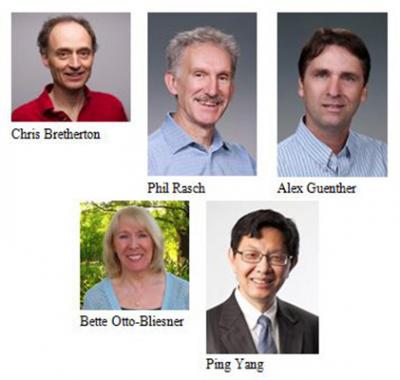Five Colleagues Elected to AGU Fellowship
Distinguished Earth and Environmental System Modeling colleagues, Chris Bretherton, Phil Rasch, Alex Guenther, Bette Otto-Bliesner, and Ping Yang, are among the 60 American Geophysical Union (AGU) Fellows elected for 2015. The new Fellows were honored during the 2015 AGU Fall Meeting in San Francisco, Wednesday, December 16, 2015. Bretherton of University of Washington, Rasch of Pacific Northwest National Laboratory, Guenther of University of California, Irvine, Otto-Bliesner of the National Center for Atmospheric Research, Boulder, and Yang of Texas A&M, will join the class of scientists being honored by AGU for "exceptional scientific contributions and attained acknowledged eminence in the fields of earth and space science."
Bretherton co-developed the moist turbulence and shallow cumulus parameterizations used in the Community Atmosphere Model (CAM5) and served on the Earth and Environmental System Modeling's (CESM) Scientific Steering Committee. He is a co-principal investigator of an Earth System Modeling project to understand the development of double-inter-tropical convergence zone biases in tropical Pacific rainfall.
Rasch is known for his extensive work on versions of the Community Climate Model throughout his career. He served as a co-chair of the CESM Atmospheric Model Working Group and led the development of CAM5. Currently, Rasch serves on CESM’s Scientific Steering Committee and is a member of DOE's Accelerated Climate Modeling for Energy (ACME) modeling project. He also serves as co-chair of the development team for the atmospheric component of ACME and the ACME council.
Guenther leads the ongoing development of the biogenic volatile organic emission approach that has been a component of the CESM Community Land Model since 2003. He has led studies that have used CESM to investigate the role of biogenic volatile organics in the climate system and understand their interactions with human activities.
Otto-Bliesner is involved in the development and simulations of CESM, with emphasis on past climate change. She has acted in a leadership role in the CESM Paleoclimate Working Group since its inception in 1997. She led collaborative projects to simulate the transient climate evolution of the last 21,000 years to incorporate carbon and stable water isotopes into CESM and, most recently, to model the long-term coupled climate-Greenland ice sheet evolution and the implications for sea level.
Yang is a co-principal investigator of the CESM project “Major improvements on the longwave radiative interactions between surface and clouds in the Polar Regions in atmospheric global circulation model (GCM).” His focus is on developing the single-scattering properties of snow particles, updating the ice cloud bulk optical property in the radiation module in CESM, and modifying the Longwave Rapid Radiative Transfer Model to enhance the modeling capabilities regarding the longwave scattering by clouds.
Each year, individual AGU members are honored for exceptional scientific contributions and acknowledged eminence in the fields of Earth and space sciences. Since the AGU Fellows program was established in 1962, no more than 0.1 percent of the organization’s 62,000-member of the total worldwide membership are recognized annually.

